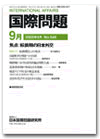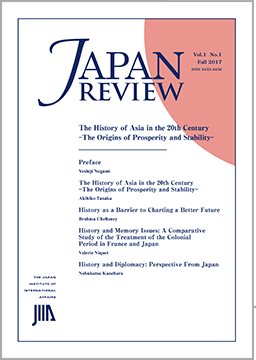Column/Report
|Top page|Print/Mobile page|Tweet
JIIA Strategic Comments(No.4):
Export Controls for Emerging Technologies:
The Implications of DOC’s Recent Notice
Yoshiaki Takayama
(Research Fellow, Center for the Promotion of Disarmament and Non-Proliferation (CPDNP), JIIA)
On November 19, 2018, the US Department of Commerce (DOC) began accepting public comment on the definition and identification of 14 categories of emerging technologies regarded as essential for national security. “Emerging technologies” are seen as capable of having impacts that could change the rules of the game by altering the military balance of power as well as relations between key market actors. Herein I would like to consider the implications of this advance notice of proposed rulemaking (ANPRM) by the DOC.
Notice by US Commerce Department (solicitation of public comment)
Controlling exports of dual-use (military-civilian) technologies in the US is the responsibility of the Bureau of Industry and Security (BIS), DOC. In identifying such technologies, consideration is given to the development of emerging and foundational technologies in foreign countries, the effects export controls may have on the development of such technologies in the US, and the effectiveness of export controls on limiting the proliferation of such technologies in foreign countries.
The DOC’s November 19 notice described representative general categories of “emerging technologies” as essential for US national security:
(1) Biotechnology (synthetic biology, genomic and genetic engineering, etc.)
(2) Artificial intelligence (AI) and machine learning technology
(3) Position, Navigation, and Timing (PNT) technology
(4) Microprocessor technology
(5) Advanced computing technology
(6) Data analytics technology
(7) Quantum information and sensing technology (quantum computing, quantum encryption, etc.)
(8) Logistics technology
(9) Additive manufacturing (e.g., 3D printing)
(10) Robotics (micro-drone systems, swarming technology, etc.)
(11) Brain-computer interfaces
(12) Hypersonics
(13) Advanced materials
(14) Advanced surveillance technologies
With regard to these 14 categories, the DOC welcomed public comment on the following points, indicating that the BIS is principally interested in means of defining/identifying “emerging technologies” and the effects/impacts of export controls:
1. How to define emerging technology to assist identification of such technology in the future
2. Criteria to apply to determine whether there are specific technologies within these general categories that are
important to US national security
3. Sources to identify such technologies
4. Other general technology categories that warrant review to identify emerging technologies that are important
to US national security
5. The status of development of these technologies in the United States and other countries
6. The impact specific emerging technology controls would have on US technological leadership
7. Any other approaches to the issue of identifying emerging technologies important to US national security
(including the stage of development or maturity level of an emerging technology that would warrant consideration
for export control)
Background to notice (solicitation of public comments)
Transfers of technologies that have both civilian and military applications are said to be significantly more useful in improving the military development/manufacturing capabilities of recipient countries than would be transfers of military goods themselves. In short, underlying this recent notice are likely security concerns that China’s acquisition of foreign technologies will contributing to its effort to modernize military. These concerns are felt not only by the Trump administration but widely shared across party lines in the US Congress. The US government has pointed out that China employs a diverse mix of legal and illegal means to acquire technologies. Illegal acquisition of technologies has traditionally taken the form of technology theft by spies, but new approaches have been taken through cyber-espionage.
The acquisition of technologies by legal means has also garnered attention in recent years. Security concerns about technology transfers via the corporate merger and acquisition (M&A) or the establishment of joint ventures (JV) have increased, with leading to the reform of Committee on Foreign Investment in the United States (CFIUS Reform). Setting aside the details for another time, modernizing CFIUS, this reform quite simply imposed tighter restrictions on foreign investments in industries and facilities deemed essential to US national security. The primary intent of it was thought to be clearly to limit Chinese investment in US.
Concerns have also heightened over transfers of technology through the acceptance of foreign researchers and joint research. Of specific concern are joint research/development projects with foreign educational/research institutions or foreign researchers/students, research guidance for foreign researchers/students, and the outflow of technologies to these researchers’/students’ home countries (and the subsequent use of the technologies for military purposes).
Let’s consider an example. As this paper was being prepared, it was reported that HIV-resistant twins were produced in China using genome editing technology. The veracity of this report is not yet clear, but the Chinese researcher reportedly studied at US universities before returning to his homeland. Genome editing counts as one of the emerging technologies (biotechnology) listed in the DOC’s recent notice. While this case is not directly connected with Chinese military development, it does highlight the possibility of a Chinese researcher acquiring “emerging technologies” in the US, returning home to China and then producing previously unanticipated research results. Instances such as this have made the US extremely nervous about transfers of knowledge, data, and know-how needed for military modernization via educational/research institutions.
Technology transfers through educational/research institutions
The recent DOC’s notice was intriguing from the perspective of technology acquisition by China, especially technology transfers through educational/research institutions. The notice drew a distinction between “emerging technologies” essential to US national security and “foundational technologies”, and said the DOC intends to solicit public comment separately on identifying “foundational technologies” important to US national security.
Heretofore, the US has excluded “fundamental research” and published information from its export controls. Accordingly, technology transfers to foreign research institutions or foreign researchers were exempted from restrictions as long as they fell under the category of “fundamental research”, a policy that the US did not even change in the wake of 9/11. This stems from the idea that an open R&D structure serves as the basis for the US’ technological supremacy. The US has consistently adopted an approach regulating only core technologies without inhibiting technology development, as also evidenced by the Reagan-era National Security Decision Directive 189 (NSDD-189). This latest notice follows a similar line, soliciting views on the impacts that controls on specific emerging technologies would have on the US’ technological leadership. It is possible, however, that the US will someday clearly designate “foundational technologies” and “emerging technologies” as essential for US national security and segregate these from “fundamental research”. This could come in the form of an attempt to classify certain technologies as “foundational technologies” and “emerging technologies” essential to US national security in order to subject them to regulation.
Such an attempt would face difficulties from the outset. The terms “fundamental research”, “foundational technologies” and “emerging technologies” that have already appeared frequently in this comment are not easy to conceptually and clearly isolate and differentiate. In terms of a unilinear understanding, technology developments start from “fundamental research” and “foundational technologies” and pass through “the valley of death” before arriving at “applied technologies” for social implementation. In reality, though, these stages are not mutually exclusive and, what’s more, if the categorization of terms and concepts is not of help in formulating actual export control policies or implementing export controls, then it will inevitably cause confusion on the ground. Furthermore, “fundamental research” and “foundational technologies” that constitute part of the technological development/practical application process differ in focus from “emerging technologies” that are defined by the novelty of the technologies themselves. With some technologies, these multiple concepts could even intersect. Nevertheless, from the perspective of ensuring the effectiveness of regulations, enabling the research institutions and researchers involved to utilize the regulations is critical. If the terms and concepts are vague, it will be no easy task to ensure that regulations are enforced effectively while guaranteeing robust technology transfer (academic exchange).
Implications of technology transfer regulations in the US and their impact on Japan
It can be inferred from the DOC’s notice that certain technology transfers/technical assistance pertaining to specific “emerging technologies”, as distinct from “fundamental research” and “foundational technologies”, could be made illegal as part of a policy to prevent China from acquiring “foundational technologies” and “emerging technologies” essential to US national security, reflecting the US’ determination to maintain its global technological superiority. The security concerns over China’s acquisition of technologies are not unique to the Trump administration. During the Obama presidency as well, security concerns were repeatedly voiced about China’s technology acquisitions. These differ from the US-China trade war that has escalated since the start of the Trump era. As mentioned earlier, US security concerns about technology acquisitions by China have been shared across administrations and party lines.
Indeed, the US is not the only country with security concerns about China’s acquisition of technologies through universities and research institutions. The Chinese scientist who made a breakthrough in quantum communications in 2017 obtained his PhD from the University of Vienna. Since last year, concerns have been arose that Chinese researchers in Australian universities and research institutes are engaged in work capable of being diverted to military use. Their areas of research span a broad spectrum, including image/video analysis, computer vision, machine learning and high-tech ceramics, and many of these technologies fall under the category of “emerging technologies” as defined in the US DOC’s recent notice. Suspicions (concerns) that “emerging technologies” have been introduced into China through educational/research institutions and are being used to enhance China’s military capabilities are spreading beyond national borders. New steps by the US designed to restrict access to technology could be incorporated into the export control policies/regulations of other countries.
Japan is no exception in any of these regards. Together with the US, Japan has a responsibility to prevent the uncontrolled transfer of “foundational technologies” and “emerging technologies” essential to security. A regulatory framework for technology in line with US efforts to regulate technologies will need to be developed to ensure that Japanese researchers and research institutions can work on joint research with their US counterparts. Standardizing technology regulations internationally will also provide a foundation for smoothly pursuing joint international research. Without such a foundation, Japanese researchers and research institutions engaged in joint research with researchers and research institutions from countries that the US regards as competitors could find themselves restricted in their ability to participate in joint research in the US or excluded altogether from the joint research framework. Japan should accordingly, as an initial step, work with allies and friendly countries to design and construct a common regulatory framework for technology. As noted earlier, any effort to demarcate the concepts of “fundamental research”, “foundational technologies” and “emerging technologies” will encounter difficulties. Consequently, the Japanese government must cooperate with the academic community to conceive and pursue with these countries a mutually feasible and effective regulatory framework governing technology.
(November 30, 2018)
(2018-11-30)
Topics
Membership
 Archive of high-quality scholary works translated from Japanese to English
Archive of high-quality scholary works translated from Japanese to English
A highlight of JIIA's recent activities and a summary of its organization.
Publication
Journal

Kokusai Mondai (International Affairs)
No.680 April 2019 "Protecting Human Rights via International Procedures"
Vol.2 No.4 Spring 2019
"Japan and the Post-World War II Liberal International Order"
Books
 What Do Alliances Mean to the US?
What Do Alliances Mean to the US?
(Fumiaki Kubo ed., 2013)






